|
1971 - Pilots and photographers
As has already been recorded, the original hangars had been moved onto neighbouring land during the war and were brought back to the Aerodrome soon after hostilities ceased. Even though they had been a permanent feature since they were built in 1935, they were only granted temporary planning permission when rebuilt. The hangars were an essential part of the Aerodrome being used for storage and maintenance of aircraft. In 1971 an application was again made to retain Hangar M, but the permission was only granted for three years, so the aerodrome operator decided it necessary to apply for permanent permission. The Council decided that the matter should be resolved by referring it to a public enquiry.
Aerodrome supporters, including Lady Douglas, who lived in the nearest house to the aerodrome, tenants, aircraft owners, pilots and concerned parties attended. They put forward the argument that hangarage was a basic necessity for wooden or fabric covered aircraft, for repairs and maintneance and for the storage of equipment. Nevertheless, the enquiry refused to grant permanent permission. Bickerton's Aerodromes felt obliged appeal against this decision causing further great stress and expense. Finally, on 2 November 1972, after a long and expensive process for the aerodrome and for the taxpayer, permanent permission was granted. Among other things, the inspector said; "It is unfortunate that aircraft noise causes inconvenience" and the Secretary of State for Air considered it, "inappropriate to secure control over the established uses on the airfield by restricting the permission for this permanent building".
|

Hangar M, used for both maintenance and hangarage, was the subject of the public enquiry into its permanent status in 1971.
|
An even more serious threat to the aerodrome came from the plans to build a new estate of 389 houses on the 47 acres of land between Tilehouse Lane and the North Orbital Road, the A412. This would have effectively caused the aerodrome to close as flight safety would have been severely compromised. The plans had been first mooted in 1969 and the first application by the developers for planning permission had been denied in 1970. In March 1971, an appeal to refuse the application was vigorously defended by local residents and Bickerton's Aerodromes and ultimately was passed to the office of the Secretary of State for the Environment, Mr Peter Walker. He recognised that the land in question was approved metropolitan green belt and denied the appeal, stating that the housing "would irreparably diminish the quality of the green belt and its recognised objective of creating a barrier to the unrestricted sprawl of metropolitan development into open countryside." The Secretary of State also made reference to the proposed Colne Valley Regional Park, the 45 square mile brainchild of Mr E B Pooley, the Planning Officer for Buckinghamshire, Chairman Mr Peter Malynn and their colleagues, who had worked long and hard to agree a cohesive plan with the many local councils in the park's scope between Rickmansworth in the north and Wraysbury in the south. After seven years hard work, the team behind the park received Government approval for the scheme in January 1972. By its very nature, Denham Aerodrome fitted in well with the plans for the green park, supporting as it does a wide range of wildlife, particularly birds of prey.
|
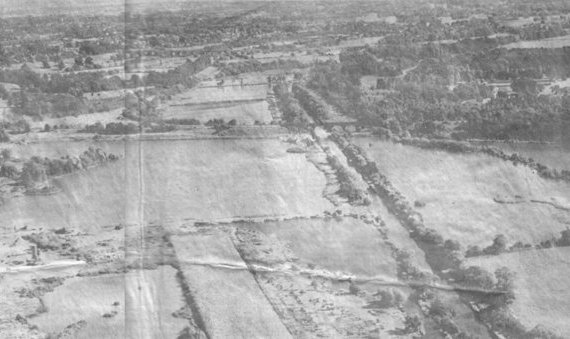
Just a small part of the land covered by the the proposed Colne Valley Regional Park, looking south past Denham and Iver to Wraysbury and Staines in the far distance. This far sighted plan was developed between 1965 and 1971, receiving approval in January 1972 and included the development of the parks, lakes and waterways enjoyed by many today.
|
The man responsible for the many of the aerial images of the area around the aerodrome, including the one above, was the Staff Photographer for the local paper, the Buckinghamshire Advertiser, Paddy Hember. A resident of New Denham, Paddy had been taking aerial photographs for many years, mostly flying from Denham. In 1971, he decided that merely riding in the aircraft he was using for his art was no longer good enough, and began his Private Pilot’s Licence at Denham using the Gregory School of Flying's Cessna aircraft. As well as these types, he also had an ambition to fly some of the older aircraft on the airfield, especially a Tiger Moth. He was to qualify for his licence in 1973 and became a popular figure at the aerodrome, organising trips abroad for groups of aircraft amongst other events.
|
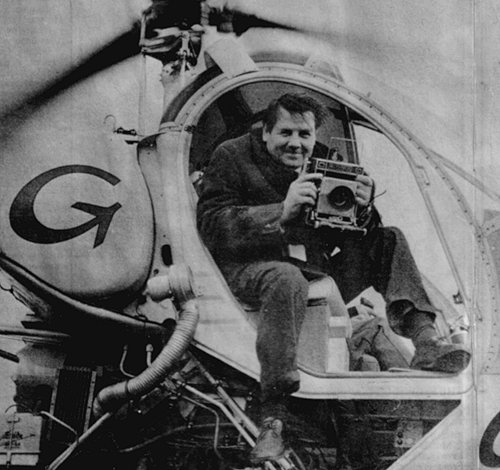
Paddy Hember doing what he was most famous for, aerial photography.
|
Another photographer of note at Denham, and one of the pilots who had supported the application for the permanent status of Hangar M, was Harry Elkin. Elkin was the chief photographer for ejection seat manufacturer Martin Baker in Denham, as well as being chairman of the Spartan Flying Group in 1971. On top of all this, while looking for an aircraft with which to compete in the London to New York Air Race in 1968, he had found a very rare type mouldering quietly away on Redhill aerodrome, immediately forgot about the air race and purchased it, then brought it back to Denham to rebuild it with his friend Edwin Harris. The aircraft in question was a Messerschmitt Me 208, one of two prototypes built by French company Nord as the Nord 1100 during the occupation. One of the prototypes had been destroyed during the war, the second had been brought over to the UK and then abandoned at Redhill. For the next two and a half years, the two men stripped, cleaned and refurbished this unique machine, finding little corrosion but needing to rewire the entire electrical system amongst other problems. Their efforts were rewarded in March 1971 when G-ATJW took to the air for the first time in many years. Fast and powerful with a 240hp eight-cylinder Argus As 10C-1 engine, the aircraft easily outperformed many of the more modern light aircraft with its maximum speed of 189 mph. Later in the year, their hard work was further vindicated when Elkin and Harris won the Decca Concours d'Elegance trophy at the Jersey Air Pageant, the first time the trophy had been won by an aircraft based in England for five years.
|
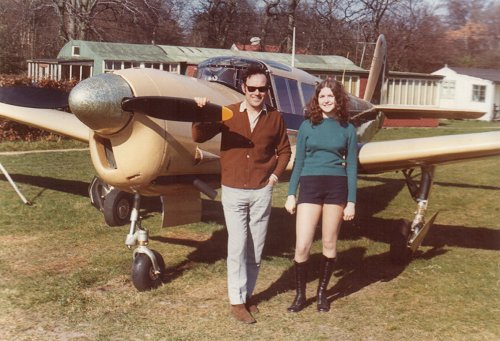
A proud Harry Elkin with his daughter in front of the superbly restored Messerschmitt Me 208, G-ATJW.
|
|
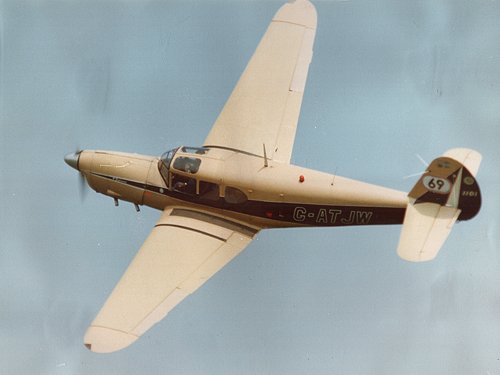
Harris and Elkin's Messerschmitt Me 108, or Nord 1100, in flight. Not only a rare aircraft, but a fast and elegant one too.
|
Two other pilots at Denham were making a name for themselves in 1971, but not in a way many would imagine! Like many people involved in British general aviation, flying instructor Brian Lecomber, a man we will hear more of later in this history, and one of his students, David Please, were both increasingly concerned about the state of the aircraft industry, especially the light aircraft industry. To highlight their concerns they came up with an unusual protest, one which attracted the attention of the newspapers and television news. The two men enclosed themselves in glass topped coffins, to signify the death of the British aircraft industry, and remained so entombed for over two weeks. Both men had learned to fly in de Havilland dH.82a Tiger Moths and were pointing out that no British built replacement for the biplane trainer was available, the American and French aviation companies were flooding the market due to a lack of Government support for the light aircraft manufacturers in the UK.
|
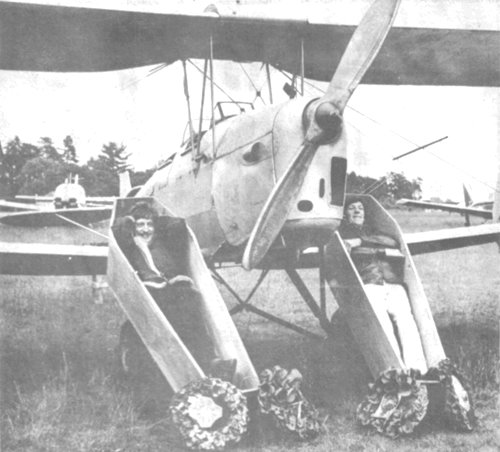
Brian Lecomber, 24 (left), and David Please, 27 (right), in their protest coffins supported by a symbol of their cause, a de Havilland dH.82a Tiger Moth.
|
One of the most popular pilots at Denham at the time was Hugh Kennedy, the affable chief pilot for United Biscuits. In March 1971, after a flying career of over 11,500 hours in 39 years without a single mishap, Kennedy was awarded his Master Air Pilot Certificate by the Guild of Air Pilots and Navigators. Having joined the Royal Air Force in 1932, Kennedy had begun his flying career on Bristol Bulldogs, Hawker Demons and Gloster Gauntlets, before moving on to his first monoplane, the Hawker Hurricane. He spent the war as a test pilot for Miles aircraft before becoming the founding pilot of the United Biscuits Aviation Division at Denham in 1959, a position he still held twelve years later.
|
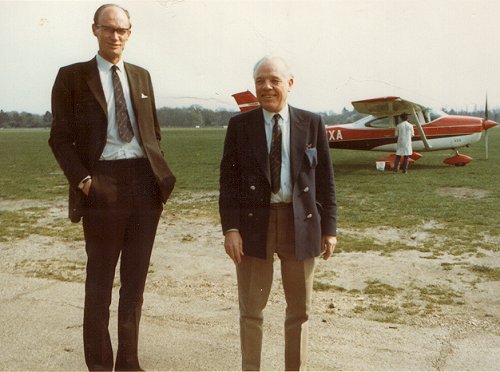
Ian Paul, a civil engineer and one of the directors of Bickerton’s Aerodromes, with Hugh Kennedy, the popular chief pilot for United Biscuits.
|
Changes big and small came to the aerodrome during the year, the main runway 06/24 was marked out in chalk on the grass in June, later changed due to magnetic variation to 07/25. The Western Section of the Metropolitan Police Flying Club decided to move closer to London, so changed its base from White Waltham to Denham and became affiliated with the Gregory School of Flying. The Western Section consisted of a Piper Colt and two Rollason Condors, but also used the Air Gregory Cessna fleet for training new members. However, one of the biggest changes at Denham in 1971 went unnoticed by many people. As has already been described, Air Gregory had been taken over by the Bristol Street Motors Group, but in April they sold their interests, and the remaining Gregory fleet, to John Delaney of the Medminster Group. John Delaney was a former Merchant Navy Bosun who had developed a wide portfolio of companies after 1948, when he had left his sea-going career and started work as a bill poster. He soon developed that job into his own business as a billboard and then sign maker. This first company quickly developed into providing exhibition stands and equipment, then the transport these required. Renovating exhibition equipment followed, then also providing furniture and set dressing for the film and television industries. These various companies were amalgamated into the Medminster Group in June 1969. Delaney's first aviation interest began in February 1970 when he purchased Kentair Charters, an air taxi company, and the Surrey and Kent Flying Club at Biggin Hill. Seeing that Air Gregory was decreasing its air taxi fleet and concentrating more on helicopters, Delaney purchased Air Gregory Holdings in April, bringing his total fleet to 30 aeroplanes and four helicopters.
|
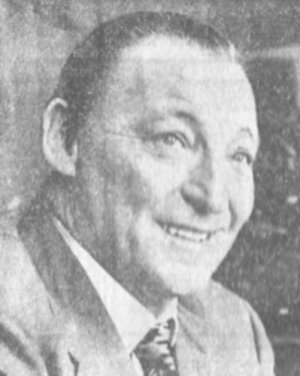
John Delaney of the Medminster Group purchased Air Gregory Holdings in April 1971.
|
The Air Gregory helicopter fleet also underwent a number of important changes during the year. It was becoming increasingly apparent that a large number of the noise complaints received by the aerodrome were caused by the helicopters used for training, particularly the Hughes 269C or 300 models. After discussions with the Denham Aerodrome Consultative Committee (DACC), Air Gregory replaced the tail rotors on all their training helicopters with an advanced version that greatly reduced the noise created by the aircraft. These were not cheap, but were indicative of the lengths Denham operators would go to in order to be good neighbours.
|
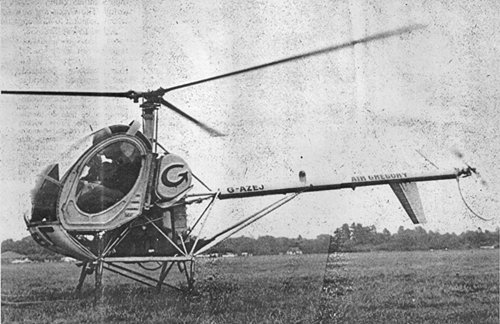
Although grainy, this image of Air Gregory Hughes 269C G-AZEJ was taken just after it was refitted with the new advanced tail rotor to reduce noise.
|
The Chief Flying Instructor for Air Gregory was a brilliant ex-Royal Navy helicopter pilot, Mike Smith, who was to have a long association with Denham, in fact his legacy continues today as will be related later. He and other Air Gregory helicopter pilots were in the news during 1971. Mike Smith and Charles Daniel took one of the company Hughes 300 helicopters to Germany to take part in the World Helicopter Championships. A total of 37 civilian and military teams from 11 countries attended the event, including five British military entries. The Air Gregory team achieved fifth place overall, a remarkable achievement. In December, Mike Smith was to assist an even more famous figure, as seen below!
|

Air Gregory pilot Mike Smith not only achieved 5th place in the World Helicopter Championships in 1971, in December he was to assist Father Christmas with his delivery schedule!
|
1971 certainly was a year of change for Denham Aerodrome, but those changes were to set the scene for the rest of the decade, including the return of a great event, as will be related next.
|
|

